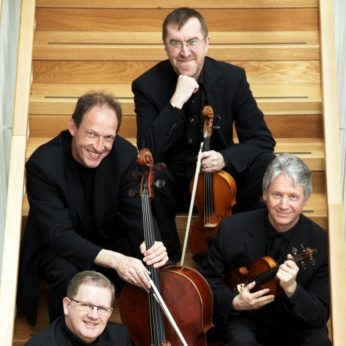In November 1822 Beethoven was asked by a Russian noble, Prince Nicholas Galitzin, a long time admirer of Beethoven’s music, to name his price for the composition of three string quartets. His request coincided with the commission for the Ninth Symphony so it was two years before Beethoven finally made a start on the Galitzin commission, which became the E-flat, A minor and B-flat quartets. The B-flat in its original version, which will be played in this performance, was the third of the Galitzin Quartets to be completed, Beethoven starting on it as soon as he finished Op.132.
Beethoven’s notebooks tell an interesting story about this quartet. He began it without any plan as to how he would continue and the unusual number of movements seems to have been the result of a creative block that led him to revive ideas discarded from the two earlier quartets in the series. The first two movements were written very quickly, but he got badly stuck on the third movement and eventually turned to a completely new idea. At this stage he contemplated moving straight to the finale but decided instead to resurrect the Alla danza tedesca, which had been discarded from Op.132. Now he suddenly found himself able to complete his original third movement, which thus became the magical Cavatina. He now thought he was home and dry as a normal finale would only take him ten days or so to write, but he had trouble choosing a theme, eventually landing on an idea he had once considered for the finale of Op.127. As he began work on the movement, it metamorphosed almost by accident into the gigantic Grosse Fuge, costing him another four months of work.
This story explains why this quartet gives the impression of being a number of musical visions loosely strung together instead of different acts in a musical drama moving inexorably towards its conclusion. The six movement format harks back to the divertimentos of his youth and Beethoven seems to have gone out of his way to make this quartet more than usually accessible, that is, until he presents us with that stupendous finale. The other big movement is the strange opening movement, with its obsessive changes of tempo resulting from integrating the Adagio introduction into the main Allegro. Indeed the first appearance of the Allegro is immediately cut short by the Adagio, a process repeated many times as the two tempi struggle for domination. Just once we are given a moment of peaceful resolution in a passage of great beauty in the development.
The Presto – Scherzo is Beethoven at his most laconic, treating brevity as the ultimate virtue. The Andante begins very seriously, but, after two bars, Beethoven swerves into an amiable melody, redolent of another era. The bittersweet themes are embedded in a graceful and flowing accompaniment almost as if this really were an eighteenth century divertimento. The Alla danza tedesca is nearly as gracious, a popular German Dance in quick three-four time, refined and developed in Beethoven’s late manner, another interlude before the emotion of the Cavatina and the drama of the Grosse Fuge.
The Cavatina employs another favourite device of Beethoven’s, the operatic aria, where the first violin takes the part of the singer – a mezzo in this case – while the other three instruments play a relatively simple and unobtrusive accompaniment. The glorious melody seems simple but its broad, carefully arched lines contain subtle irregularities of phrasing that contrast pleasingly with the straightforward dance rhythms of the Alla danza tedesca. Beethoven himself was deeply moved by his own music, filled as it was with intense longing, which becomes even more anguished in the profound middle section.
The maddest fugue in Western music can be rationalised into an introduction, three fugues and a coda. The brief introduction plays the main subject, first of all in plain octaves and then in the form it is to have in the succeeding fugues beginning paradoxically with the third one. The first fugue however is based on a second subject with a driving dotted rhythm with the first subject in the passenger seat as a pianissimo counter subject. The relentless power of this fugue is overwhelming and stretches the musicians and the listeners to their limit, music for the creation of a new world.
The second fugue returns to the subject announced in the introduction. After the striving of the first fugue this gentle music seems like glimpses of a paradise lost. Eventually this works up a magnificent climax, which then leads quickly into the third fugue. Here both themes are brought together along with a change to six-eight time. This fugue is as long as the other two together but halfway there is a fortissimo return to the second fugue and subsequently the music seems to be looking for the way home. Finally the coda is reached with the openings of the first and second fugues and then a full statement of the main theme. There are a few hesitant remembrances of things past before the final blaze of light.
